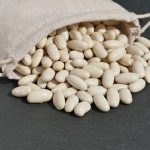Matcha powder is made from high-grade green tea leaves that are ground into a fine powder. The powder from green tea is put into hot water that is already frothy to create the drink.
Presenting and sipping matcha is the key part of the Japanese tea ceremony.
Although matcha powder originally was used in ceremonies, it has become increasingly popular in recent years in drinks such as tea lattes and boba tea. It is also used as an ingredient in cooking, appearing in dishes such as ice cream and salad dressing.
Matcha Origins
Instead of using teapots, early Chinese people ground tea leaves into a powder. They would then whip or beat the ground tea in a bowl with hot water. The Chinese abandoned the method of “beaten tea” in favor of steeped tea leaves. The Japanese went on to popularize the method.
One of Japan’s own Zen priests studying in China’s Buddhist monasteries returned to Japan in the early 12th century with tea plant seeds and bushes. The young priest, Eisai, had experience growing and drinking tea in China. He used this to popularize the idea of “the way of tea” as a meditation ritual within his community of Japanese Buddhist monks. He eventually made tea drinking throughout Japan a custom.
This tea drinking ceremony was adopted with great enthusiasm by Japan’s samurai class. Samurai were both fearsome warriors and high ranking members of Japanese caste society. They were known for their skills in combat as well as their culture and refinement.
Despite being known for their warrior culture, samurai identity was actually built on the principles of Zen Buddhism, such as discipline, ritual, and purification.
It is widely believed that the samurai played a large role in shaping the Japanese tea ceremony into the elaborate art form and cultural tradition that it is today. This is due to the fact that they added hundreds of intricate steps to the practice, including specifying certain hand movements, the ideal design of the tea room, and guidance on the proper way to sit and consume the tea.
Some people say that the tea ceremony was an important part of training for samurai warriors. They say that it helped the warriors improve their skills such as focus, concentration, and patience.
The Japanese tea ceremony, still called The Way of Tea, is a revered practice in Japan that is focused on the art of preparing and presenting matcha in an almost meditative fashion.
Tea ceremony was originally developed as a spiritual practice. The principals of the practice—harmony, respect, purity, and tranquility—are still central to it today.
Types of Matcha
Matcha is a green tea that is grown in many regions across Japan. The flavor profile and color of the final ground green tea leaves will be different depending on the region and the tea maker.
Matcha is typically sold in two different grades:
Ceremonial grade
Ceremonial grade matcha is made from the highest quality leaves and buds, and is the best quality matcha. The ceremonial grade of matcha is the best quality because it is the freshest and most delicate tasting. It is also the smoothest ground matcha.
Ceremonial grade matcha is best enjoyed without any sweeteners or additives in order to fully appreciate the intended flavor.
Culinary grade
Matcha that is designated as “culinary grade” has a stronger, more bitter taste that can hold its own against other flavors it is paired with.
The leaves in this type of matcha may not have been ground as finely as in ceremonial grade, there may be some stems and veins still attached, and the color may be slightly duller green. It’s often a mix of matcha powder from several sources.
Culinary grade matcha can still be made into tea and drunk; in fact, it’s a great matcha to mix with milk for lattes or spirits for cocktails. It is less expensive than some other options, making it a more affordable cooking ingredient.
Caffeine Content in Matcha
Matcha contains more caffeine than green tea, similar caffeine to black tea, and less caffeine than brewed coffee. Since matcha is made from tea leaves that grow in the shade, they contain more caffeine.
You are consuming more caffeine content from matcha than from green or black tea because you are consuming the ground tea leaf.
However, the amount of caffeine in a cup of matcha tea will depend on how the matcha was processed and prepared.
Make sure you read the packaging or ask your tea supplier how much caffeine is in the matcha you’re buying.
Preparing Matcha
Matcha is prepared differently from a typical brewed tea and is very easy to make if you have the right tools.
Bring 100 mg (about 1/3 cup) of filtered or spring water to a boil. Wait for the mixture to cool for a couple of minutes before removing it from the heat.
Place 1/2 teaspoon matcha powder in a small bowl. To make the paste, add a splash of the hot water and mix with a bamboo whisk.
Add the rest of the water to the bowl and stir the mixture until the matcha is fully mixed in and you have a thin frothy layer on top.
Step 4: Sip, savor, and enjoy.
Tips
- If you don’t have a bamboo whisk, use a spoon or small wire whisk—you just won’t get much of the frothy texture traditionally prepared matcha is known for.
- Don’t be tempted to pour boiling water over matcha; you will scorch the ground tea powder and it will become bitter and astringent.
- Use 1/4 cup water for a thicker matcha or 1/2 cup water for a thinner version.
- Replace water with your favorite milk (regular, coconut, almond, soy) for a latte.
- Pour the just prepared matcha over a glass full of ice for an iced tea version.
Tasting Matcha
Since matcha is whisked into hot water, the resultant drink has a unique richness that is not found in other teas that are brewed using the traditional method.
Matcha’s flavor is often described as being vegetal, wheatgrass-like, slightly sweet, and slightly astringent. Its texture is often described as being creamy, rich, and full-bodied, with a frothy top layer.
Buying and Storing Matcha
Matcha is best enjoyed as quickly as possible after it is made. Since matcha is a ground tea, it will start to degrade in color and flavor if it is exposed to oxygen.
If you keep it in a cool, dark place, it can stay fresh for a few weeks or even a few months.
Buy matcha green tea from a reputable company to get the most fresh and flavorful tea. Find out when and how the tea was processed and packaged for the best quality. You should inquire from your tea supplier on the most ideal way to brew that specific sort of matcha.
Health Benefits of Matcha
Many studies have found that green tea has various health benefits. While much of the research has been done with green tea, the benefits also extend to matcha since matcha is made from whole green tea leaves.
1. May help fight cancer
Lots of researchers have looked into whether green tea can help stop cancer from developing. Women in an older study who drank more green tea were found to develop cancer 7.3 years later on average than those who drank less green tea.
This study found that people who drank eight cups of green tea per day were less likely to have their cancer return and had a longer disease free period, on average, than those who only drank two cups a day.
2. May help prevent type 2 diabetes
Some animal studies suggest that green tea may help to combat diabetes by causing the body to release more insulin (Zhao, 2022). Insulin is a hormone that helps to move blood sugar into cells and be used as energy.
Green tea may improve cells’ response to insulin and lower blood sugar levels, which could be as effective as some medications. More research is needed in humans to further support these findings.
3. May help combat depression
The study found that people who drank more than four cups of green tea per day were less likely to have depressive symptoms, compared to those who drank less than one cup per day.
A study done in Japan found that older adults have similar results. According to Niu (2009), adults 70 years or older who drink four or more cups of green tea a day are 44% less likely to experience symptoms of depression compared to those who drink one cup or less a day.
4. May help protect brain function
An analysis of 36 studies found that green tea helps protect against cognitive disorders. These brain problems, which are more common after the age of 65, typically affect learning, memory, movement, language, attention, and problem solving.
The disorders mentioned vary in severity, from mild cognitive impairment to more serious diseases such as dementia, Parkinson’s disease, and Alzheimer’s disease. The data indicated that those who consumed more green tea were better protected against disorders.
Studies in both animals and humans have shown that green tea helps to reduce stress, and in turn, its negative effects on brain function and brain health. It also helps to suppress brain aging (Unno, 2021).
5. May improve male fertility
The research found that men who drank tea had a higher total sperm count and greater sperm concentration than those who never drank tea.
For men who drank tea at least three days a week, there was an increase in sperm count (Liu, 2022).
Scientists noted that green tea contains high quantities of polyphenol antioxidants after a review of already-published research. These antioxidants prevent damage to healthy cells, including those in testicular tissue.
Green tea may also help improve the movement of semen and its ability to survive.
6. May help reduce cholesterol
A research analysis showed that people who drink green tea and are at a healthy weight usually have lower levels of total cholesterol and LDL cholesterol.
LDL is called the “bad” cholesterol because it causes a buildup of cholesterol in arteries, which makes heart disease more likely (MedlinePlus, 2020).
7. May reduce blood pressure
Consuming green tea has been shown to lower both the systolic and diastolic blood pressure. The study found that people who had high blood pressure or other heart disease risk factors saw even greater effects.
This is partly because green tea can help to relax your blood vessels, which improves blood flow and reduces inflammation.
8. May protect bone health
Lee (2022) found that postmenopausal women in Korea who didn’t drink green tea or who only drank one cup a day were more likely to have reduced bone mass compared to those who drank three cups a day.
Other research has found a link between drinking tea and a reduced risk of osteoporosis. It is probable that the drink’s efficacy is a result of its antioxidants, which have been shown to protect against bone loss and improve bone growth.
Nutrition
Matcha is a healthy option because it is low in calories and nutrients, but rich in antioxidants. There is a lot of nutrition packed into one teaspoon of matcha powder, the amount used in many recipes to make a single matcha latte. According to the USDA, just one teaspoon provides:
- Calories: 7
- Carbohydrates: 0g
- Fat: 0g
- Protein: 0g
- Calcium: 6mg, 1% of the daily value
- Iron: .28mg, 1% of the daily value
Matcha contains antioxidants which help to cleanse the body, reduce inflammation and protect cells from damage. This can prevent aging and disease.
Matcha green tea has more caffeine than steeped green tea. The amount of caffeine present in matcha can vary from 18.9 to 44.4 mg per gram.
One teaspoon of matcha powder is approximately two grams. This means that the caffeine level in matcha ranges from 37.8 to 88.8 mg. While one cup of green tea contains more caffeine than a can of cola, it is still less than what is in a cup of coffee.
Read More: Tea Or Coffee Which Is Better For Weight Loss









